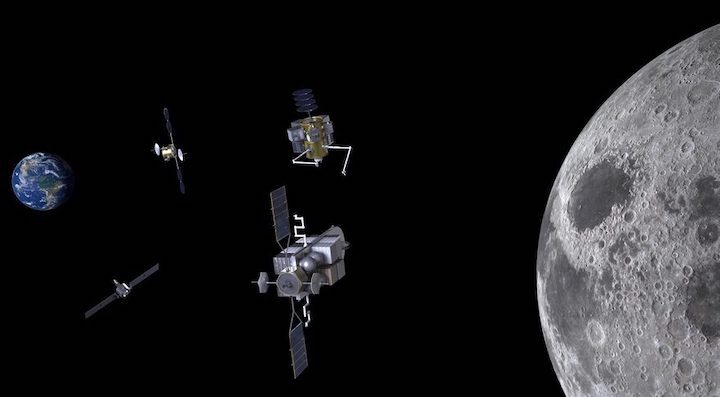5.02.2022

WASHINGTON — A startup led by a former acting administrator of NASA has announced plans to develop platforms serviced by robotic vehicles in cislunar space to support a range of applications.
Maryland-based Quantum Space announced Feb. 3 it’s starting work on a spacecraft platform that would initially operate at the Earth-moon L-1 Lagrange point and host various payloads. That platform would be serviced by another spacecraft that would deliver and install payloads.
“We’re trying to transform the way we deploy and operate spacecraft,” said Steve Jurczyk, co-founder, president and chief executive of Quantum Space, in an interview. “We’re really an in-space services company, and those services are enabled by a new platform called an outpost, which is a spacecraft designed to be serviceable.”
The outpost, he said, would consist of two components. One is a spacecraft bus that serves as a platform for hosting payloads, using modular “plug-and-play” interfaces. The other is a spacecraft that would deliver payloads to the platform and install them using robotic manipulators.
Those payloads could include communications, navigation, remote sensing, space domain awareness and space weather sensors, Jurczyk said. Those payloads would primarily come from customers, but he said the company is looking at developing its own payloads, particularly for imaging of the Earth and moon.
He said starting operations at the Earth-moon L-1 point, about 60,000 kilometers from the moon in the direction of Earth, offers a “clean sheet” approach compared to working in Earth orbit. “We think that there’s an opportunity to be the first to deploy capabilities in cislunar space to support NASA and Artemis, and to support the national security community and its requirements there,” he said. “There are no other legacy systems there to compete with.”
That first platform would be in operation in 2025 or 2026. First, though, would be what Quantum Space calls a “pathfinder” mission launching in 2024, which Jurczyk described as a small spacecraft with a remote sensing payload to test operations at the Earth-moon L-1 point.
The company believes these outposts can be done with existing technology. “I don’t think there’s any new technology per se that we need to develop,” he said. “A lot of it has been developed by NASA, and we can license it from NASA and other government agencies.” The company is also looking at systems ranging from spacecraft buses to robotic arms available from industry. He added the company is still working on “make-buy” decisions regarding what components to build in-house and which to purchase from other companies.
Jurczyk is one of the three co-founders of Quantum Space. Another is Ben Reed, former division chief of exploration and in-space services at NASA’s Goddard Space Flight Center and who worked on satellite servicing projects there. He is the chief technology officer of Quantum Space. The third co-founder is Kam Ghaffarian, who also helped start commercial space station company Axiom Space and lunar lander developer Intuitive Machines after selling Stinger Ghaffarian Technologies. They’re joined by Kerry Wisnosky, the co-founder and former principal owner of Millennium Engineering and Integration, who is the chief operating officer of Quantum Space.
Jurczyk retired from NASA last May after more than 30 years at the agency, including three as the agency’s associate administrator. He was acting administrator of NASA for the first three months of the Biden administration, until the Senate confirmed Bill Nelson as administrator.
After leaving the agency, he said, “I wasn’t ready to retire. I wanted to do something else.” He wanted to stay in the space industry, and after discussions with Ghaffarian decided to lead Quantum Space.
Ghaffarian provided what Jurczyk called a “good amount” of seed funding to start the company, which he said will support the company through early 2023. “That will allow us to build the company, staff up, and get pretty far along with the pathfinder mission as well as the design of the outposts and robotic servicing vehicle,” he said. Quantum Space expects to have 25 to 30 employees by the end of the year and 50 to 70 by the end of 2023.
Quelle: SN
